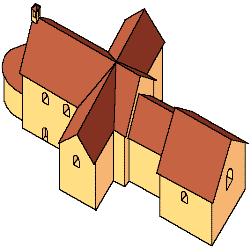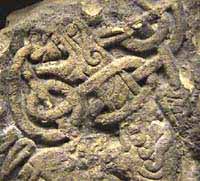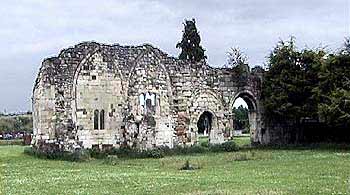
EBK Home
Kingdoms
Royalty
Saints
Pedigrees
Archaeology
King Arthur
Mail David
St. Oswald's Priory, Gloucester
Founded AD 890
 St. Oswald's Priory in Gloucester
was founded by the last King of Mercia, Aethelred II, and his formidable
wife, Lady Aethelflaed, in about 890. Aethelflaed was the daughter of her
husband's overlord, the powerful King Alfred the Great of Wessex.
She had been virtually ruling the Kingdom of Mercia since her husband had
been struck down with a debilitating illness about two years before.
Perhaps the foundation was undertaken in the hope of some divine relief
for the ailing monarch. It was certainly part of a major rebuilding
programme in the city, as the place was being fortified as part of a
string of Mercian defensive burghs.
St. Oswald's Priory in Gloucester
was founded by the last King of Mercia, Aethelred II, and his formidable
wife, Lady Aethelflaed, in about 890. Aethelflaed was the daughter of her
husband's overlord, the powerful King Alfred the Great of Wessex.
She had been virtually ruling the Kingdom of Mercia since her husband had
been struck down with a debilitating illness about two years before.
Perhaps the foundation was undertaken in the hope of some divine relief
for the ailing monarch. It was certainly part of a major rebuilding
programme in the city, as the place was being fortified as part of a
string of Mercian defensive burghs.
The Priory Church, initially dedicated to St. Peter, was constructed from re-used Roman stones stripped from the ruins of Glevum. The builders may actually have made systematic use of a nearby Roman Temple, in line with church recommendations of the time. Associated buildings were probably of wood. Though, it was a monastery of the traditional type housing secular canons, St. Oswald's is of especial interest to architectural historians. There were very few churches built during the late eighth century, when the risk of plunder and burning by Viking Raiders was at its height, and it is therefore seen as something of a 'missing-link' dubbed the 'last of the minsters'.
 The
site itself began life as a Christian cemetery filled with finely carved
memorial crosses. It may have been the Royal Mercian Cemetery for the
nearby Palace of Kingsholm. The first church, erected in the 890s, was of
a somewhat standard, if not old fashioned plan: a rectangular nave with
two small portici (or chapels) projecting to the north and south. However,
it did have the added interest of a western apse as seen in contemporary,
though much larger, churches in the Continental Carolingian Empire. In
909, in a major show of Mercian power and influence, Lady Aethelflaed and
her husband managed to obtain the greater portion of the relics
of St. Oswald, 7th century King
of Northumbria. This Mercian defeated monarch had lain unnoticed at
Bardney Abbey since the place had been destroyed when Viking settlers took
over Lincolnshire. Aethelflaed's brother, King Edward the Elder of
Wessex, retrieved the saintly monarch's body in a daring raid on Viking
territory and it was brought to Gloucester (minus head and arms) with
great pomp and ceremony and interred in the new Royal Priory Church. An
elaborate eastern crypt, similar to that still extant at Repton and
supported by four central columns, had been prepared for his arrival. Both
this and the slight remains of structural carving, recovered from the
site, clearly show the importance attached to St. Oswald's. There was also
a cross-wall in the nave which appears to have been painted with a large
depiction of angels flying over the crucifixion. It acted as a
rood-screen. We can only imagine the portable decoration of rich hangings,
candlesticks and other ornaments. The building was quickly rededicated to
St. Oswald and Aethelflaed and her husband appear to have chosen to be
buried in the crypt alongside their patron saint.
The
site itself began life as a Christian cemetery filled with finely carved
memorial crosses. It may have been the Royal Mercian Cemetery for the
nearby Palace of Kingsholm. The first church, erected in the 890s, was of
a somewhat standard, if not old fashioned plan: a rectangular nave with
two small portici (or chapels) projecting to the north and south. However,
it did have the added interest of a western apse as seen in contemporary,
though much larger, churches in the Continental Carolingian Empire. In
909, in a major show of Mercian power and influence, Lady Aethelflaed and
her husband managed to obtain the greater portion of the relics
of St. Oswald, 7th century King
of Northumbria. This Mercian defeated monarch had lain unnoticed at
Bardney Abbey since the place had been destroyed when Viking settlers took
over Lincolnshire. Aethelflaed's brother, King Edward the Elder of
Wessex, retrieved the saintly monarch's body in a daring raid on Viking
territory and it was brought to Gloucester (minus head and arms) with
great pomp and ceremony and interred in the new Royal Priory Church. An
elaborate eastern crypt, similar to that still extant at Repton and
supported by four central columns, had been prepared for his arrival. Both
this and the slight remains of structural carving, recovered from the
site, clearly show the importance attached to St. Oswald's. There was also
a cross-wall in the nave which appears to have been painted with a large
depiction of angels flying over the crucifixion. It acted as a
rood-screen. We can only imagine the portable decoration of rich hangings,
candlesticks and other ornaments. The building was quickly rededicated to
St. Oswald and Aethelflaed and her husband appear to have chosen to be
buried in the crypt alongside their patron saint.
Pilgrims flocked to St. Oswald's in the following centuries and these generous visitors enabled the establishment to obtain much land as well as rich treasures. It was the centre of a large parish, possibly based on Royal estates, on the outskirts of the city which eventually became a Free Royal Church. It also maintained a chapel at the Kingsholm Palace. In the 10th century the church at St. Oswald's expanded, with the addition of a tower. The canons produced their own bells for this new edifice in a bell-pit excavated on the site. The western apse was demolished and a clerestory window converted into a door, suggesting the addition of a western gallery inside as at nearby Deerhurst.
 By the time of the Norman Conquest,
however, the place was in decline. St. Oswald's was appropriated by the
Archbishop of York and, at last, reformed: the secular canons being
replaced by Augustinian ones in 1153. The building was repaired and
enlarged over the years - the remaining arches are 12th and 13th century -
but it was now firmly eclipsed by the adjacent Abbey of St. Peter
(Gloucester Cathedral). Its medieval decline was further stimulated by an
acrimonious dispute over ownership between the Archbishops of York,
Canterbury and the Bishop of Worcester. This led the latter to
excommunicate the canons of St. Oswald's and forbid the citizens of
Gloucester from trading with them! Eventually King Edward I was forced to
intervene. Reasserting its Royal Free Chapel status, he claimed the priory
was exempt from episcopal power and lifted the ban. The complex survived
the Dissolution of the Monasteries in 1530s, though the last seven canons
and their servants were naturally ejected. The arches of the north aisle
were blocked up and it became the parish church of St. Catherine in 1548.
It was a highly popular place of worship for a while. However, the
building was largely destroyed by Royalist cannon fire during the Civil
War Siege of Gloucester and was eventually demolished, by the City
Council, in 1653. The stone was used to rebuild a new market house. Only
the northern arcade of the nave survived, built into a series of outhouses
and sheds. It remains preserved today as a picturesque ruin in a park off
Archdeacon Street.
By the time of the Norman Conquest,
however, the place was in decline. St. Oswald's was appropriated by the
Archbishop of York and, at last, reformed: the secular canons being
replaced by Augustinian ones in 1153. The building was repaired and
enlarged over the years - the remaining arches are 12th and 13th century -
but it was now firmly eclipsed by the adjacent Abbey of St. Peter
(Gloucester Cathedral). Its medieval decline was further stimulated by an
acrimonious dispute over ownership between the Archbishops of York,
Canterbury and the Bishop of Worcester. This led the latter to
excommunicate the canons of St. Oswald's and forbid the citizens of
Gloucester from trading with them! Eventually King Edward I was forced to
intervene. Reasserting its Royal Free Chapel status, he claimed the priory
was exempt from episcopal power and lifted the ban. The complex survived
the Dissolution of the Monasteries in 1530s, though the last seven canons
and their servants were naturally ejected. The arches of the north aisle
were blocked up and it became the parish church of St. Catherine in 1548.
It was a highly popular place of worship for a while. However, the
building was largely destroyed by Royalist cannon fire during the Civil
War Siege of Gloucester and was eventually demolished, by the City
Council, in 1653. The stone was used to rebuild a new market house. Only
the northern arcade of the nave survived, built into a series of outhouses
and sheds. It remains preserved today as a picturesque ruin in a park off
Archdeacon Street.
